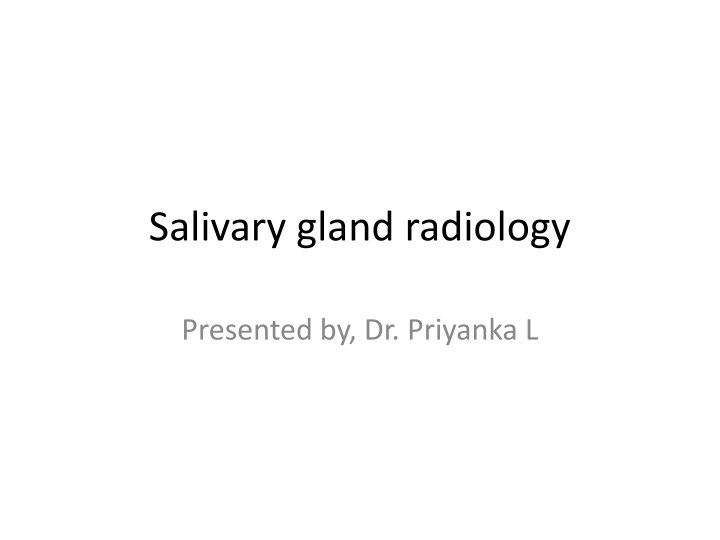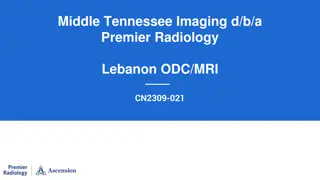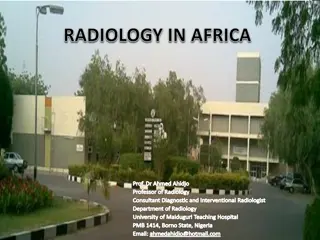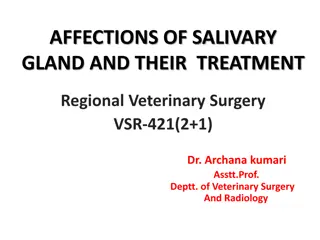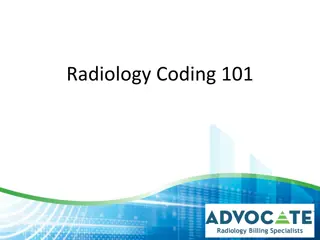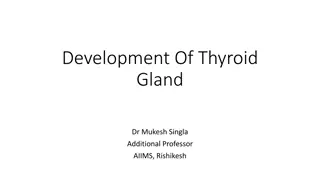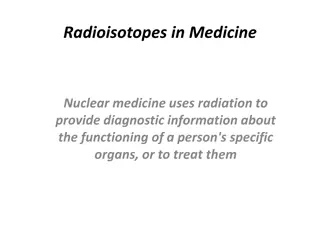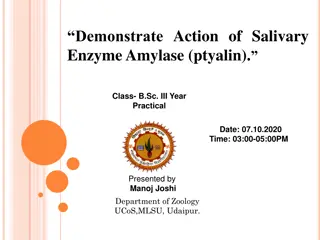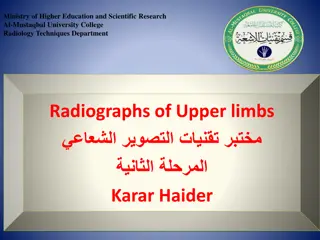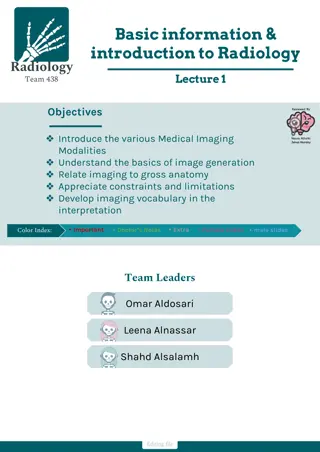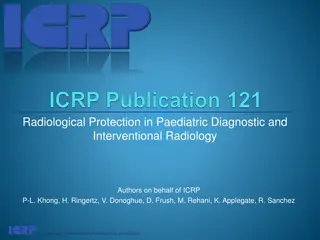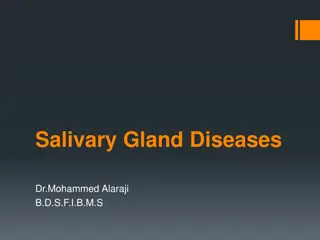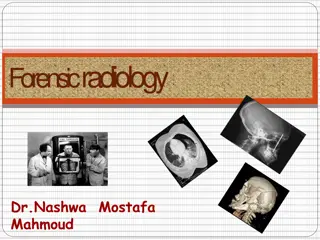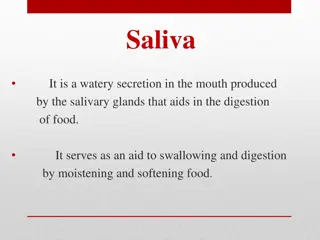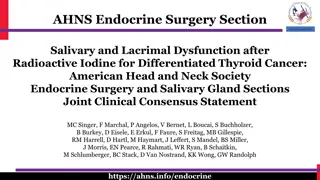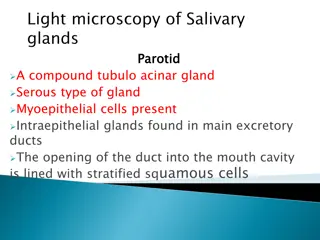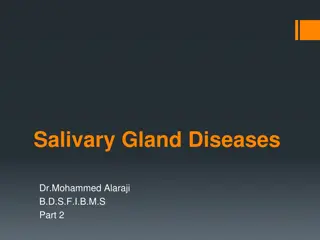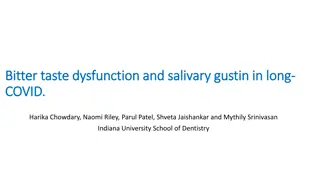Salivary Gland Radiology for Diagnostic Imaging
Salivary gland radiology plays a crucial role in differentiating between inflammatory and neoplastic diseases, identifying sialoliths, and aiding in biopsy site selection. Various imaging techniques such as plain film radiography, intraoral radiography, extraoral radiography, and conventional sialography are utilized to demonstrate specific aspects of salivary gland pathology, enabling accurate diagnosis and treatment planning.
Download Presentation

Please find below an Image/Link to download the presentation.
The content on the website is provided AS IS for your information and personal use only. It may not be sold, licensed, or shared on other websites without obtaining consent from the author.If you encounter any issues during the download, it is possible that the publisher has removed the file from their server.
You are allowed to download the files provided on this website for personal or commercial use, subject to the condition that they are used lawfully. All files are the property of their respective owners.
The content on the website is provided AS IS for your information and personal use only. It may not be sold, licensed, or shared on other websites without obtaining consent from the author.
E N D
Presentation Transcript
Salivary gland radiology Presented by, Dr. Priyanka L
Applied diagnostic imaging To differentiate inflammatory from neoplastic disease Diffuse from focal suppurative disease Identify and localize sialoliths Demonstrate ductal morphology Anatomic location of tumor Differentiate benign from malignant disease Demonstrate relationship b/w mass and adjacent anatomic structures Aid in the selection of biopsy sites
Plain film radiography PA skull r/g may demonstrate bone lesions PA r/g with puffed cheek to demo parotid stones Not well calcified stones are r lucent and not visible on r/g
Intraoral r/g Sialoliths in anterior 2/3rdof submandibular duct are imaged with a cross sectional mandibular occlusal projection Posterior part of the duct is demo with posterior oblique view posterior oblique view, here head of pt is tilted back and maximally inclined toward the unaffected side CR is directed parallel with mandible in area of submandibular fossa and into the posterior part of the FOM Liths in anterior part of stensons duct is imaged with intraoral r/g
Extraoral r/g OPG demo stones in posterior duct or demo intraglandular liths in submandibular gland Parotid liths is superimposed over ramus and body in lateral r/g Liths in submandibular gland, lateral projection is modified by opening the mouth, extending the chin, and depressing the tongue with index finger Sialoliths in distal portion of parotid duct PA with puffed cheek
Conventional sialography Is a r/g technique wherein a r opaque contrast agent is infused into the ductal system of salivary gland before imaging with plain films It is the most detailed way to image the ductal system Survey or scout film is usually made before the infusion of contrast solution into ductal system A lacrimal or periodontal probe is used to dilate the sphincter at ductal orifice before the passage of cannula connected by extension tubing to a syringe containing contrast agent
Lipid soluble and non lipid soluble contrast solution is then slowly infused until the pt feels discomfort Filling phase is monitored by fluoroscopy or with static films Intent is to opacify the ductal system all the way to acini Image of ductal system appears tree limbs Image of acinar filling appears as tree comes to bloom Gland is allowed to empty for 5 mts without stimulation If postevacuation images shows contrast agent, a sialogogue such as lemon juice or 2% citric acid may be admininstered to augment evacuation by stimulating secretion
Non-lipid soluble contrast agents are preferred For evaluation of chr inflammatory diseases and ductal pathoses Contraindications include: acute infection Known sensitivity to to iodine containing compounds Immediately anticipated thyroid function tests
Computed tomography Is useful In evaluating structures in and adjacent to salivary glands It displays both hard and soft tissues as well as minute differences in soft tissue densities Axial and coronal images are typically acquired Glandular tissues are usually easily discernible from surrounding muscle and fat Parotid glands are more r opaque than surrounding fat but less opaque than adjacent muscles
Submandibular and sublingual glands are similar in density to adjacent muscles, they are identified on basis on shape and locality CT is useful in assessing acute inflammatory processes and abscesses, as well as cysts, mucoceles and neoplasia Calcifications, such as sialoliths are also well depicted with CT
Magnetic resonance imaging Typically provides better images of soft tissue structures than does Ct It also results in few problems with streak artifacts from metallic dental restorative materials Noncontrast T1 and T2 weighted sequences are obtained followed by T1 weighted postcontrast, fat suppressed images MRI demo as well as or better than CT the margins of salivary gland massses, internal structures and regional extension of lesions into adjacent tissues or spaces It also discloses major vessels, appears as areas of no tissue signal without the use of contrast media Use of iv contrast is helpful in distinguishing b/w cystic and solid masses in evaluation of perineural spread of malignant tumors
Scintigraphy Provides a functional study of salivary glands, taking advantage of selective concentration of specific radio pharmaceuticals in glands 99m Tc-pertechnetate is injected iv, it is concentrated in and excreted by glandular structures, including the salivary, mammary and thyroid glands Radionuclide appears in ducts of salivary glands within minutes and reaches maximal concentration within 30 to 45 mts A sialogogue is then administered to evacuate secretory capacity All major glands cane studied at once b
High diagnostic sensitivity Lacks specificity and little morphology Pathosis can be demo by an increased, decreased or absent radionuclide uptake Lesions that concentrate r nuclide are Warthin tumor and oncocytoma
Ultrasonography US has the advantages of being relatively inexpensive, widely available, painless, easy to perform and noninvasive Primary application is in differentiation of solid masses from cystic masses Useful in detecting liths and diagnosing advanced autoimmune lesions
Obstructive and inflammatory disorders Sialolithiasis Bacterial sialadenitis Sialodochitis Autoimmune sialadenitis
Sialolithiasis Syn: calculus and salivary stone Liths may appear r opaque or r lucent They vary in shape from long cigar shapes to round and oval Homogenous, r opaque internal structure Contrast agent flows around lith, filling the duct proximal to obstruction Ductal system is frequently dilated proximal to obstruction Contrast agent that flows around lith is more r opaque and may obscure small liths R lucent liths appear as ductal filling defects
US is reliable in demonstrating liths More than 90% of liths larger than 2mm appear as echo-dense spots with characteristic acoustic shadow Phleboliths radiolucent center Calcified lymph nodes appear cauliflower shaped
Bacterial sialadenitis Is contraindicated in acute infections coz of disrupted ductal ept where extravasation of contrast agent may occur and have foreign body reaction and severe pain Ept flattening may lead to midly terminated terminal ducts and sac like acini Sac like acinar areas are referred to as sialectasia An even distribution throughout the gland is seen in recurrent parotitis and AI disordersabscess cavities appear on CT as walled off areas of lower attenuation within an enlarged gland
US may distinguish b/w diffuse inflammation (echo free, light image) and suppuration (less echo-free, darker image) Us may detect liths more than 2mm in diameter US is the study of choice for recurrent parotitis, splly in children Contrast enhanced CT may demo glandular enlargement MRI is appropriate tech in which sialography is contraindicated or technically not possible On MRI, inflammed glands are usually enlarged and demo low tissue signal of T1 weighted and high On T2 than surrounding muscle
Sialodochitis Syn: ductal sialadenitis It is inflammation of the ductal system of salivary glands It is seen in submandibular and parotid glands It is seen as dialtation of ductal system on sialography If interstitial fibrosis develops, it appears as sausage string of main duct and its major branches produced by alternate strictures and dilations
Autoimmune sialadenitis Sialography is helpful in diagnosis and staging of AI disorders Early stages initiation of punctate, less than 1mm and globular, 1-2mm spherical collections of contrast agent evenly distributed throughout the glands These collections are called as sialectases At this stage, main duct appear to be normal but intraglandulr ducts may be narrowed or not even evident
Sialectasia typically remains after the administration of a sialogogue which indicates that contrast agent is pooled extraductally As disease progresses, collections of contrast agent increase in size, greater than 2mm in diameter and irregular in shape These pools of contrast agent are called cavitary sialectases These larger sialectases are fewer in no and less uniformly distributed throughout the glands
Progressive larger cavities of contrast agent and dilation of main ductal system may also be present At endpoint, complete destruction of gland occurs Cavitation and glandular fibrosis are result of recurrent inflammation
Noninflammatory disorders Sialadenosis Cystic lesions Benign tumors
Sialadenosis Syn: sialosis It is a nonneoplastic, noninflammatory enlargement of primarily parotid glands Usually related to metabolic and secretory disorders of parenchyma associated with diseasesd of nearly all endocrine glands Protein deficiencies, malnutrition in alcoholics, vitamin deficiencies and neurologic disorders c/f: affected glands are typically enlarged
Radiographic features Sialography may demo enlargement of the affected glands or a normal appearance In enlarged glands, ducts will be splayed
Cystic lesions Cysts are rare Occur unilalerally May be congenital (branchial), lymphepithelial, dermoid or acquired Cystic lesions may be intraglandular or extraglandular Benign lymphoept cysts are sequalae of cystic degeneration of salivary inclusions within lymph nodes Multiple parotid cysts associated with HIV are reported
Radiographic features On sialography, cystic masses are indirectly visualized by displacement of the ducts arching around them Cystic lesions aooear as well circumscribed, nonenhancing (with contrast), low density areas on CT Appear as well circumscribed, high signal areas on T2 MRI US, cysts are sharply marginated and echo-free (as dark area)
Benign tumors Typically have well defined margins and are most apparent on CT and MRI Coz of higher density of submandibular gland, which can equal that of neoplasm and obscure the tumor Iv contrast enhancement is required during CT examination This causes the tumor to appear more r opaque coz the vascularity of tumor is greater than adjacent salivary gland tissue
US benign masses are typically sharply defined, less echogenic than parenchyma, and of essentially homogenous echo strength and density Benign tumors appear as low intensity (dark) or high intensity (light) signals on MRI Relative intensity of signal may indicate presence of lipid, vascular or fibrous tissues Space occupying lesions ducts are compressed or smoothly displaced around the lesion (ball in hand appearance)
Benign mixed tumor Syn: pleomorphic adenoma CT sharply circumscribed, infrequently lobulated and essentially round homogenous lesion with higher density than adjacent gland Calcifications within tumor are well depicted on CT Various tissue signals on MRI: Relatively low / dark in T1 weighted images Intermediate on proton density weighted images Homogenous high density / bright on T2 weighted images
Foci of low signal intensity / dark areas usually represent areas of fibrosis or dystrophic calcifications If a calcification is present (signal void), diagnosis favors a benign mixed tumor Tumor appears cold spot on scintigraphy Solid tumors larger than 5mm are usually well visualized
Warthin tumor Syn: papillary cystadenoma lymphomatosums CT and MRI are preferred techniques CT this may be either a soft tissue or cystic density MRI it is heterogenous and demo hemorrhagic foci Intensely hot on scintigraphy scans US appears as a solid mass, hypoechoic unless it appears to be cystic in nature
Hemangioma Syn: vascular nevus Is a benign neoplasm of proliferating endothelial cells (congenital hemangioma) and vascular malformations, including lesions resulting from abnormal vessel morpogenesis c/f: frequently occuring nonepithelial salivary neoplasm Most common tumor during infancy and childhood Av age opf diagnosis is 10 yrs Are frequently unilateral and asymptomatic 2:1:: female to male ratio
Radiographic features Phleboliths are common in this tumor Appears as calculi with a r lucent centre and best identified on plain films and CT Displaced ducts curving about the mass may also be apparent on sialography CT presentation of hemangioma is a soft tissue mass that is well distinguished from surrounding tissue, splly when IV contrast is used MRI similar signal of tumor and adjacent muscle on T1 weighted images and a very high signal on T2
US usually demonstrated well defined margins in hemangioma, illdefined margins may also be noted Strongly hypoechoic hemangiomas may have a complex appearance Coz of multiple interferences in lesion Phleboliths appear as multiple hyperechoic areas within the body of the gland itself
Malignant tumors Is variable and is related to grade, aggressiveness, location and type of tumor Illdefined margins, invasion of adjacent soft tissues and destruction of adjacent osseous structures are typical indicators of malignancy
Mucoepidermoid carcinoma Low grade tumors are typically not apparent on plain film r/g unless destructive changes to adjacent osseous structures have occurred Low grade tumors present as lobulated or irregularly shaped circumscribed appearance on CT or MRI Cystic areas may present and rarely calcifications may be seen High grade carcinomas relies on irregular margins and ill defined form when the mass is examined with CT or MRI
CT with contrast -- sharply defined homogenous mass that is considerably more opaque than on CT without contrast CT is reliable tech for detection of bony invasion Low signal intensity on T1 and T2 weighted MRI T1 weighted images have low intensity / are darker than surrounding structures and are relatively homogenous T2 weighted images are more heterogenous and intensed / brighter than T1 and are just darker than surrounding structures
Malignant mixed tumor Is same as high grade mucoepidermoid carcinoma MRI is usually more superior to CT for tumor definition
Other malignant and metastatic tumors Presentation is nonspecific and similar to that of high grade mucoepidermoid carcinoma US may demonstrate echo-free cystic areass in adenoid cystic carcinomas
